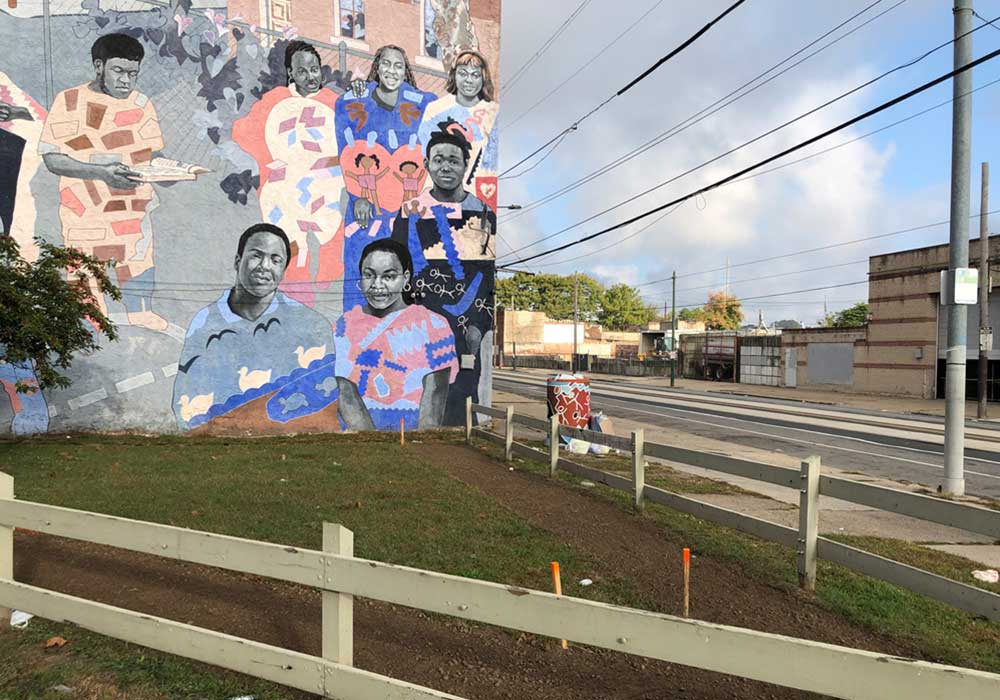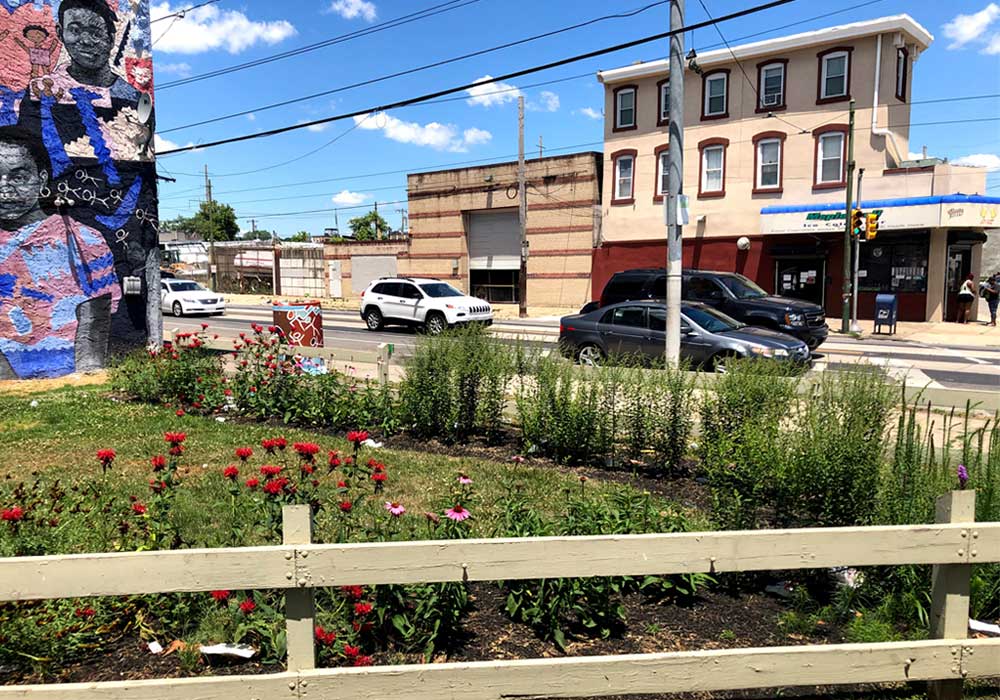Combating Climate Change Through Vacant Lot Restoration

Climate is changing at a faster pace than anticipated. The rising temperatures and increased frequency and intensity of extreme weather events have called for unprecedented and urgent action. Cities or urban centers are particularly at risk, especially those with significant impervious cover and low tree canopy, as this contributes to increased flooding events and the urban heat island effect.
As we know, planners can play an essential role in combating climate change. One of the ways to do this is by rethinking the utilization of vacant lots. These spaces present an opportunity to help communities become more resilient to the impacts of climate change while also providing co-benefits like improving health and protecting native wildlife. Here, I share a story of how the Pennsylvania Horticultural Society (PHS) Philadelphia LandCare program in partnership with the National Wildlife Federation (NWF) has successfully piloted this model to achieve these goals and beyond.
Utilizing Vacant Lots for Green Spaces
A study done in 2016 found that, on average, around 17% of land area in large US cities is considered vacant. It also found that most of these parcels are small, odd-shaped, and disconnected, which provides an ideal opportunity to transform these parcels into climate-resilient green infrastructure that can also serve as a wildlife habitat corridor for some of our most critical species: pollinators. Moreover, the pandemic and the accelerated digitalization of life may create additional vacant spaces in our urban core, thus offering more opportunities in the future to transform these vacant, unused, and often neglected parcels of land into vibrant, usable green spaces.
There are various benefits of transforming vacant lots into green spaces, including stormwater management and improved water quality. Planners understand the social, economic, and environmental benefits that nature and green spaces provide. In addition to these benefits, the recent COVID-19 pandemic has highlighted the importance of nature in improving mental health. Hence, integrating nature in all aspects of planning, including vacant lot transformation, is not a disagreeable or disputable concept. The question is how to do it in a resource-constrained environment.
Transforming Vacant Lots Into Resilient Green Spaces
Pennsylvania Horticultural Society (PHS) uses horticulture to advance the health and well-being of the Greater Philadelphia Region. PHS's Philadelphia LandCare program (LandCare) is a nationally recognized model for converting vacant lots, which are often overlooked and unmaintained, into community assets. The program was launched in 2001 and today uses gardening and landscaping to clean, green, and maintain 12,000 vacant lots (16 million square feet of land) in the city. These lots are both publicly- and privately-owned and located in low- and moderate-income neighborhoods of the city.
PHS is committed to addressing the issues of inequity. Philadelphia has around 40,000 vacant lots with more vacant lots in lower- and moderate-income communities, due to a history of redlining and disinvestment. The team at PHS believes that everyone in Philadelphia should have access to quality green space, and nobody should live in a neighborhood that has unkept and aesthetically unpleasing parcels of land. So, to provide every resident with a high-quality, usable urban green space, they support and invest in disinvested communities. They hire local minority-owned businesses, contractors, and artists, to clean the lots, plant grass, and maintain these spaces, thus providing job opportunities, spurring local economic growth, and simultaneously providing opportunities for these small businesses to grow. PHS has improved the quality of life of people living near the lots through their work and strategic investments. Research has shown that residents living near the LandCare lots experienced a 40% decrease in feelings of depression, and there was a 29% reduction in gun violence in neighborhoods with LandCare lots.
Establishing and maintaining partnerships with the City of Philadelphia (which funds the LandCare program) and community-based organizations is a key factor to PHS's success. "We work and collaborate with many different organizations and institutions to help build up their work experience. We give smaller, simpler lawn care contracts to local community organizations like the Community Development Corporations; we train them and help them grow," said Samir Dalal, PHS Landcare Program Manager.
While these LandCare sites provide many community benefits, how could these green spaces be enhanced to become more resilient to climate?
NWF and PHS Create Pollinator Gardens
In 2019, one of America's largest and most trusted conservation organizations, the National Wildlife Federation (NWF), partnered with PHS to augment the PHS' LandCare program. In this project, which was funded by the Wildlife Conservation Society, NWF and PHS installed 50 300-square-foot climate-smart pollinator gardens on a network of 26 vacant lots in the Strawberry Mansion and Mantua neighborhoods of North/West Philadelphia — two communities particularly vulnerable to extreme heat and flooding risks associated with a changing climate. They collaborated on this project to improve the connectivity and diversity of wildlife habitats within the city and provide better climate resiliency in the form of improved flood management and heat absorption. Thus, providing benefits beyond what the clean and green treatment of the vacant lots generally rendered.
View an interactive map of all cleaned-up lots by PHS, including the pollinator gardens.
Visit the National Wildlife Federation's website for more information on native plants, the impacts of wildlife gardens, and national initiatives.


Before and after restoration photos of a vacant lot in the Mantua neighborhood of Philadelphia. Photos by Holly Gallagher and Natalie Cohen.
NWF Tests Native Plants for Resilience
NWF is working to ensure that wildlife thrive in our rapidly changing world and that all people have clean air and water, easy and equitable access to nature, and protection from the ravages of climate change. In cities like Philadelphia, vacant lots are often under-utilized and can be transformed into green spaces that mitigate the impacts of climate change serve as pollinator habitats, provide air and water quality benefits, and engage communities.
Through this project, NWF wanted to determine the most successful native plant design to withstand the increased temperatures and more variable and intense precipitation events predicted with the changing climate. "We wanted to know if different native plant species and their varying quantities and combinations had an impact on the garden's resilience in the face of climate change and its' ability to absorb stormwater. We wanted to find the most successful and aesthetically appealing plant combination to inform vacant lot restoration projects throughout the Mid-Atlantic," said Jen Mihills, NWF's Mid-Atlantic Regional Executive Director. To conduct this research, NWF collaborated with Dr. Chris Swan, a leading urban ecology researcher at the University of Maryland Baltimore County.
The project included selecting 50 sites using GIS and on-the-ground analysis, choosing 13 unique native plant species for planting (in a group of 4,6,8,10, or 12) in the gardens, determining the shape and design of the garden, installing the gardens, maintaining them, and in the end conducting field research to document the findings.
The research findings show that the installed pollinator gardens were more climate-resilient than the surrounding lots due to their increased ability to absorb and retain stormwater. Eight months after the gardens were planted, Dr. Swan found a significant increase in soil moisture and a decrease in soil compaction in the gardens compared to the surrounding turf grass, demonstrating the almost immediate benefits of this approach. Research also showed that the soil in the gardens was well-drained because the plants were using more water than the surrounding turf preventing excess stormwater runoff.
Overall, the selected native plants performed well to withstand the environmental pressures of the vacant lots, making a robust case for their use in greening projects. Plant survivability was high except for one of the grasses. The results also showed that the ideal planting palette for this type of vacant lot restoration includes about six to eight native plant species. This palette was determined mainly based on three factors: aesthetic appearance, community perception, and ease of maintenance. This palette also provides critical pollinator habitat and has the same ability to absorb stormwater as gardens that have more native plant species.
Pollinator Gardens Enhance Climate Resilience
Based on the scientific work of PHS and NWF in Philadelphia, it is evident that the vacant lots restored with pollinator gardens provide enhanced climate resiliency than their counterparts. Putting this idea into action could enable planners to improve community climate resiliency, plus provide necessary habitat to pollinators. Planners should work with other allied professionals such as park and recreation professionals and landscape architects to install pollinator gardens and adopt ordinances, standards, policies, and practices that support them.
APA Resources
To learn more about the work of NWF and PHS on this project, check out the corresponding APA Podcast episode.
The installation of climate-resilient pollinator gardens on Philadelphia LandCare sites was supported by a grant award made by the Wildlife Conservation Society through its Climate Adaptation Fund. Support to establish this fund was provided by a grant to the Wildlife Conservation Society from the Doris Duke Charitable Foundation.
Top image: Pollinator Garden in Strawberry Mansion neighborhood (Philadelphia). Photo by Natalie Cohen.


